The Principality of Seborga (Principato di Seborga) is considered an unofficial micro-nation, just as Sealand (a platform located off the English coast), or the Kingdom of Redonda, in the Caribbean Sea.
|
 |
 |
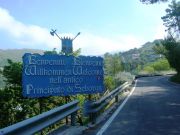 |
 |
 |
 |
 |
 |
Benvenuti nell'Antico Principato di Seborga
 |
 |
It was the end of my short journey to Eastern Europe. I had visited some special places in Romania, the Republic of Transniester, Gagauzia, the Republic of Srpska with the Brcko District, plus Ithaca Island. I was already in Italy returning back home hitch hiking, when a man who gave me a ride to Montecassino Monastery explained me the history of Seborga, and it was so interesting that I decided to pay a visit to that exotic place in my way back to Spain.
That benevolent Italian man told me that, according to historical documents, Seborga was known in the past as Castrum Sepulcri.
In the year 954 Seborga was a feud owned by the Earls of Ventimiglia, and they ceded it to the monks of Lerin islands, located in front of Cannes.
At the end of the XI century Seborga became a Principality within the Holy Roman Empire.
Then, at the beginning of the XII century, the Abbey/Prince Edward ordained nine Templar caballeros (The Knights of Saint Bernard), and consequently the Principality of Seborga became the only Sovereign Cistercian State in History.
When some years later these nine knights returned from Jerusalem to Seborga, Saint Bernard of Clairvaux himself met them in that Principality and he appointed one of them the Great Master of the Knights of Saint Bernard.
Seborga continued enjoying the status of a Cistercian State until 1729, when it was sold to Vittorio Amadeo II of Savoy, King of Sardinia. But this acquisition was never registered (and the money was never paid!). Some years later Seborga Principality was not included in the Republic of Genoa, and it was not even mentioned in the Congress of Vienna of 1815 as part of Sardinia. When in 1861 the Act of Unification of Italy took place, the Principality of Seborga was disregarded and therefore the inhabitants of Seborga never considered themselves Italians, even in 1946 when the Republic of Italia was declared.
The Italian Government, of course, takes the “independence” of Seborga as a joke.
|
|
| Favourite spots: |
This XIII century small chapel is located at about 100 metres from San Bernardo Square.
The door was closed but I pushed and could open it. The interior was charming and I inside noticed several Templar dresses and crosses that the local people use for their ceremonies every 20th of August, Saint Bernard day and “national” festivity, when all the inhabitants of Seborga, about 340, walk in procession around the main streets of their village performing rites of chivalry.
Saint Bernard of Clairvaux was a reformer of the Order of Cistercians who erected many monasteries in France, and also along the Saint James Way (El Camino de Santiago), in Spain.
He organized the monastic life of the Templar Knights, those monks’ warriors who protected the pilgrims going to Jerusalem from the assaults of the bandits.
Two of the first nine Templar Knights were Saint Bernard relatives.
|
|
| What's really great: |
 |
 |
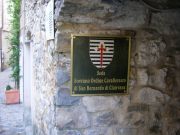 |
 |
 |
 |
 |
 |
Sede Sovrano Ordine Cavalleresco di San Bernardo di Clairvaux
 |
 |
The downtown was great. In every house there was a Seborga flag with its characteristic colours, blue and white. I also saw doors with the Templar Cross painted, and many Knights designed in the streets walls, like frescoes. I felt as if I had been transported to several centuries back in time.
In one of the walls I read the following phrase:
“Sede Sovrano Ordine Cavalleresco di San Bernardo di Clairvaux”
I asked for that place to a woman passing by and she said that the Prince of Seborga, Giorgio I, is the Master of that Order of Chivalry.
And she continued explaining that in 1960 a man named Giorgio Carbone discovered the rich history of the Principality of Seborga and that it had never been part of Italy. In 1963 he was formally appointed Prince by the major part of Seborga inhabitants.
He is very old and weak, and stays always at home.
People call him with high respect “Sua Tremendità”. He has the title Gran Priore delle Venerabilis Ordo Sancti Sepulchri de Seborga.
|
|
| Sights: |
 |
 |
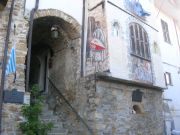 |
 |
 |
 |
 |
 |
Templar Knights paintings in Seborga walls
 |
 |
I still visited a museum with 135 different musical instruments from the medieval times, which is supposed to be unique of its kind in Italy. The entrance fee was 1 euro.
In Seborga there is a supermarket, a tobacco and a souvenir shops, all around a square with a well in the middle.
I entered in the souvenirs shop and was offered a coin of 2 Luigino, the old Principality of Seborga currency.
In the XVII century the Luigino corresponded to a quarter of a French Louis. Today is not used anymore, only for the tourists.
It was minted in 1995 and looked like a 2 euro coin. On one side there was the face of Giorgio I, and on the other side there was a sort of emblem of the Principality of Seborga,
They asked me 14 euro for that coin of 2 Luigino but, considering that it was too expensive, I did not buy it.
|
|
| Accommodations: |
 |
 |
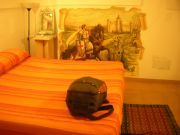 |
 |
 |
 |
 |
 |
My room, my bed, my small bag and the Templar Knight
 |
 |
After two hours walking, at about 1 kilometre before reaching Seborga, a man with a long beard picked me up and offered me a room in his friends’ hostel. I did not want to tell him that I planned to sleep in the nature, but when we reached the downtown his friends were in the main square, so they offered me a room for 30 euros.
30 euros was all that I had left. With that amount I could eat several days, but it was the end of my mini-journey in East Europe; I had been sleeping for eight days on a row in beaches, benches or in boats and I urgently needed to wash my dirty clothes and have a shower to arrive back home in Spain clean, otherwise my mother would scold me. So I bargained and finally we agreed 20 euros for the room, without breakfast, in the hostel ANTICO CASTELLO.
The room was gorgeous, spacious, with an enormous bed, hot water, two frescoes in its walls depicting Templar knights and medieval castles…I felt so good!
|
|
| Nightlife: |
 |
 |
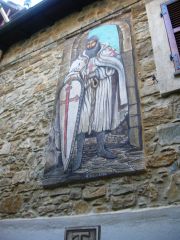 |
 |
 |
 |
 |
 |
Templar Knights everywhere. They protect Seborga.
 |
 |
There is no night life in Seborga, apart from the Trattoria San Bernardo and two or three more restaurants, in case that you find them open. If you want action and you have a car, you must go to Bordighera, in Italy, Monte Carlo in Monaco, or Nice in France, being all those places not far from Seborga. In your car, you can reach Nice, for instance, in half an hour, Monte Carlo in twenty minutes, and Bordighera in ten minutes.
In fact, Seborga people do not feel as foreigners in Monaco or Nice, where so many Italians live.
In Nice, for instance, still some people speak fluent Italian plus the local dialect, called Niçard (or Nissart), which is very close to the Italian.
Only in 1860 Nice inhabitants decided to belong to France, instead of Italy, that is why in that town you will see Garibaldi statue looking to Italy (Garibaldi was born in Nice and he was very angry when Nice people preferred to join France).
|
|
| Hangouts: |
 |
 |
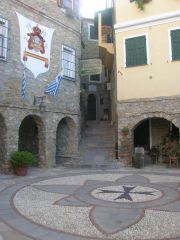 |
 |
 |
 |
 |
 |
See the Templar Cross on the floor.
 |
 |
Templar Square was a remarkable place for its medieval atmosphere.
On the floor there was a Templar Cross made with small tiles and black stones, at one side the old Monks Palace and next door there was a Church devoted to Saint Martin of Tours.
Not far from there I saw the Prince Palace, where Giorgio I lived. On its walls I read this plaque:
EMBASSY
Imperial and Royal House
De Vigo Aleramico Lascaris Paleologo of Constantinople
Government of the Roman Eastern Empire in Exile
That evening, in the restaurant where I had “dinner”, I learnt that Enrico Vigo Aleramico pretends to be a prince descending from the Emperors of the old Byzantium before Constantinople was invaded by the Turks in 1453, and he issues titles of nobility and of Chivalry, because he claims to be a Grand Master of the Constantinean Order of Saint George. He asks from 7500 to 30.000 US Dollars per title, but they are not recognized by the Nobility Societies, which is why he has been in jail several times.
|
|
| Restaurants: |
 |
 |
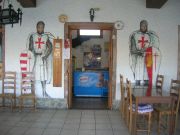 |
 |
 |
 |
 |
 |
Templar Knights everywhere, even in the dinner.
 |
 |
Trattoria San Bernardo was the only choice that I had for dinner. It is located in the main square. In front of this Trattoria there was another restaurant, but it was closed.
The Tratoria is decorated with frescos showing Templar caballeros with their horses.
In the patio the atmosphere was intimate, since all the customers knew each other, and they talked with familiarity across the tables.
The future Prince was having dinner with his family. I inquired him for Giorgio I and was told that he is ill in bed.
I had a look at the menu expecting to find medieval prices. But no! A normal dinner consisting on two dishes with pasta plus fish cost 20 euros; therefore I finally ordered a sandwich of mortadela (3 euro) plus a cappuccino (1.50 euro). I gave no tips, so I did not spend too much money and still kept some coins (5 or 6 euros) to drink a cappuccino the next morning, before heading to Spain, hitch hiking.
One of the waitresses was Charo, from Montevideo, and speaks Spanish.
|
|
| Other recommendations: |
 |
 |
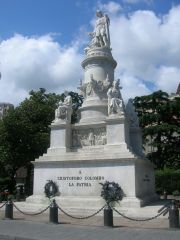 |
 |
 |
 |
 |
 |
Christopher Columbus monument in Genoa.
 |
 |
Near Seborga you have lovely Sanremo, on the Italian Riviera, with its famous Municipal Casino.
Also I can recommend you to travel to Genova (Genoa) during your visit to Seborga. It is not too far from Seborga and you can combine these two places in the same journey. In fact, I reached Seborga via Genova, where I visited the famous Palazzi dei Rolli in the Strade Nuove (also known as Via Garibaldi), at only ten minutes walking from the railway station.
These are stunning Renaissance and Baroques palaces (Palazzi) from the XVI and the XVII centuries, most of them designed by the famous Italian architect Galeazzo Alessi, which today are Patrimonies of the Humankind according to the organization UNESCO.
Another tourist attraction in Genoa is the Lighthouse (Torre della Lanterna), where Christopher Columbus relatives worked.
An impressive Columbus monument is to be found in the railway station square.
|
|
Published on Friday July 3th, 2009
|
|
 Publish on Facebook
Publish on Facebook
|
Tue, Jun 01 2010 - 06:38 AM
 by shervin19
| krys, Fabulous, your report is verry nice, Thank you! |
Wed, Jul 22 2009 - 07:51 PM
 by gloriajames by gloriajames
Tue, Jul 07 2009 - 07:23 AM
 by krisek by krisek
| Jorge, what a great report again. I am ever so impressed with your ability to discover places away from the mainstream... Very educating as always, as well. Thank you very much. |
Mon, Jul 06 2009 - 12:40 PM
 by bootlegga by bootlegga
| I'm interested by the Templars, and this is a fascinating read. |
Sun, Jul 05 2009 - 11:35 PM
 by louis by louis
| Very interesting report Jorge, I haven't heard about this Prinicipality before. |
Sun, Jul 05 2009 - 08:28 PM
 by eirekay by eirekay
| Jorge - you have included some marvelous history! |
Sat, Jul 04 2009 - 01:19 PM
 by mistybleu by mistybleu
| Great report Jorge, I ever even heard of this place before |
Sat, Jul 04 2009 - 11:29 AM
 by porto by porto
| Well done Jorge, another classic. |
Fri, Jul 03 2009 - 08:39 PM
 by pesu by pesu
| Great report about a (for me up to now) completely unknown place at the Italian/French border, interesting history about this floristry (and tourism?) entrepreneur Giorgio Carbone, Principe di Seborga. :) Thanks for sharing, Jorge. |
| Information: |
| Login if you are a member, or sign up for a free membership to rate this report and to earn globo points! |
|
| Afghanistan |
|
|
 |
| Argentina |
|
|
 |
| Bosnia - Herzegovina |
|
|
 |
| Brazil |
|
|
 |
| Canada |
|
|
|
|
|
|
 |
| Chad |
|
|
 |
| Chile |
|
|
 |
| China |
|
|
 |
| Christmas Island |
|
|
 |
| Colombia |
|
|
 |
| Dominica |
|
|
 |
| Falkland Islands |
|
|
 |
| Germany |
|
|
|

|
